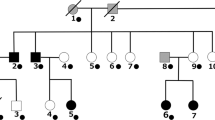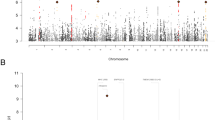Abstract
The somatostatin receptor 5 (SSTR5) gene is a candidate gene for bipolar affective disorder (BPAD) as well as for other neuropsychiatric disorders. The gene is positioned on chromosome 16p13.3, a region that has been implicated by a few linkage studies to potentially harbor a disease susceptibility gene for BPAD. Recent evidence shows that the dopamine D2 receptor (DRD2) and SSTR5 interact physically to form heterodimers with enhanced functional activity. Brain D2 dopamine receptors are one of the major targets of neuroleptic treatments in psychiatric disorders. In this study we systematically screened the promoter and coding region of the SSTR5 gene for genetic variation that could contribute to the development of neuropsychiatric disorders. Eleven novel single nucleotide polymorphisms (SNPs) were identified including four missense SNPs, Leu48Met, Ala52Val, Pro109Ser and Pro335Leu. We carried out an association study of BPAD using 80 Danish cases and 144 control subjects, and replication analysis using 55 British cases and 88 control subjects. For the Danish population, association was suggested between silent SNP G573A and BPAD (P = 0.008). For the British population we found association to BPAD with missense mutation Leu48Met (P = 0.003) and missense mutation Pro335Leu (P = 0.004). The statistical significance of the association was, however, greatly reduced after correcting for multiple testing. When combining genotypes from Leu48Met and Pro335Leu into haplotypes, association to BPAD was found in the British population (P = 0.0007). This haplotype association was not replicated in the Danish population. Our results may indicate that the SSTR5 gene is involved in the etiology of BPAD or may exist in linkage disequilibrium with a susceptibility gene close to SSTR5. However, given the marginal statistical significance and the potential for false-positive results in association studies with candidate genes, further studies are needed to clarify this hypothesis.
This is a preview of subscription content, access via your institution
Access options
Subscribe to this journal
Receive 12 print issues and online access
$259.00 per year
only $21.58 per issue
Buy this article
- Purchase on Springer Link
- Instant access to full article PDF
Prices may be subject to local taxes which are calculated during checkout




Similar content being viewed by others
Notes
D16S85 was found on compound Z69706 and D16S521 was found on compound Z69719, both on contig NT_000655, at URL: http://www.ncbi.nlm.nih.gov/genome/guide/HsChr16.shtml.
References
Ewald H, Mors O, Flint T, Koed K, Eiberg H, Kruse TA . A possible locus for manic depressive illness on chromosome 16p13 Psychiatr Genet 1995; 5: 71–81
Dib C, Faure S, Fizames C, Samson D, Drouot N, Vignal A et al. A comprehensive genetic map of the human genome based on 5264 microsatellites Nature 1996; 380: 152–154
Edenberg HJ, Foroud T, Conneally PM, Sorbel JJ, Carr K, Crose C et al. Initial genomic scan of the NIMH genetics initiative bipolar pedigrees: chromosomes 3, 5, 15, 16, 17, and 22 Am J Med Genet 1997; 74: 238–246
McInnes LA, Escamilla MA, Service SK, Reus VI, Leon P, Silva S et al. A complete genome screen for genes predisposing to severe bipolar disorder in two Costa Rican pedigrees Proc Natl Acad Sci USA 1996; 93: 13060–13065
Levitas AS, Reid CS . Rubinstein–Taybi syndrome and psychiatric disorders J Intellect Disabil Res 1998; 42: 284–292
Adams LJ, Salmon JA, Kwok JB, Vivero C, Donald JA, Mitchell PB et al. Exclusion of linkage between bipolar affective disorder and chromosome 16 in 12 Australian pedigrees Am J Med Genet 1997; 74: 304–310
Blackwood DH, He L, Morris SW, McLean A, Whitton C, Thomson M et al. A locus for bipolar affective disorder on chromosome 4p Nat Genet 1996; 12: 427–430
Coon H, Jensen S, Hoff M, Holik J, Plaetke R, Reimherr F et al. A genome-wide search for genes predisposing to manic-depression, assuming autosomal dominant inheritance Am J Hum Genet 1993; 52: 1234–1249
Detera-Wadleigh SD, Badner JA, Berrettini WH, Yoshikawa T, Goldin LR, Turner G et al. A high-density genome scan detects evidence for a bipolar-disorder susceptibility locus on 13q32 and other potential loci on 1q32 and 18p11.2 Proc Natl Acad Sci USA 1999; 96: 5604–5609
Friddle C, Koskela R, Ranade K, Hebert J, Cargill M, Clark CD et al. Full-genome scan for linkage in 50 families segregating the bipolar affective disease phenotype Am J Hum Genet 2000; 66: 205–215
Morissette J, Villeneuve A, Bordeleau L, Rochette D, Laberge C, Gagne B et al. Genome-wide search for linkage of bipolar affective disorders in a very large pedigree derived from a homogeneous population in Quebec points to a locus of major effect on chromosome 12q23–q24 Am J Med Genet 1999; 88: 567–587
Murphy VE, Mynett-Johnson LA, Claffey E, Bergin P, McAuliffe M, Kealey C et al. Search for bipolar disorder susceptibility loci: the application of a modified genome scan concentrating on gene-rich regions Am J Med Genet 2000; 96: 728–732
Ewald H, Kruse TA . Bipolar affective disorder, chromosome 16p13.3, and recessive disease genes [letter] Am J Med Genet 1997; 74: 549–550
Takeda J, Fernald AA, Yamagata K, Le Beau MM, Bell GI . Localization of human somatostatin receptor 5 gene (SSTR5) to chromosome band 16p13.3 by fluorescence in situ hybridization Genomics 1995; 26: 638–639
Deloukas P, Schuler GD, Gyapay G, Beasley EM, Soderlund C, Rodriguez-Tome P et al. A physical map of 30 000 human genes Science 1998; 282: 744–746
Brazeau P, Vale W, Burgus R, Ling N, Butcher M, Rivier J et al. Hypothalamic polypeptide that inhibits the secretion of immunoreactive pituitary growth hormone Science 1973; 179: 77–79
Patel YC, Greenwood MT, Panetta R, Demchyshyn L, Niznik H, Srikant CB . The somatostatin receptor family Life Sci 1995; 57: 1249–1265
Rubinow DR, Davis CL, Post RM . Somatostatin in neuropsychiatric disorders Prog Neuropsychopharmacol Biol Psychiatry 1988; 12: 137–155
Bissette G, Myers B . Somatostatin in Alzheimer's disease and depression Life Sci 1992; 51: 1389–1410
Patel YC . Somatostatin and its receptor family Front Neuroendocrinol 1999; 20: 157–198
Panetta R, Greenwood MT, Warszynska A, Demchyshyn LL, Day R, Niznik HB et al. Molecular cloning, functional characterization, and chromosomal localization of a human somatostatin receptor (somatostatin receptor type 5) with preferential affinity for somatostatin-28 Mol Pharmacol 1994; 45: 417–427
Yamada Y, Kagimoto S, Kubota A, Yasuda K, Masuda K, Someya Y et al. Cloning, functional expression and pharmacological characterization of a fourth (hSSTR4) and a fifth (hSSTR5) human somatostatin receptor subtype Biochem Biophys Res Commun 1993; 195: 844–852
Rocheville M, Lange DC, Kumar U, Patel SC, Patel RC, Patel YC . Receptors for dopamine and somatostatin: formation of hetero-oligomers with enhanced functional activity Science 2000; 288: 154–157
American Psychiatric Association. Diagnostic and Statistical Manual of Mental Disorder, 4th edn APA: Washington DC 1994
Sanger F, Nicklen S, Coulson AR . DNA sequencing with chain-terminating inhibitors Proc Natl Acad Sci USA 1977; 74: 5463–5467
Lathrop GM, Lalouel JM, Julier C, Ott J . Strategies for multilocus linkage analysis in humans Proc Natl Acad Sci USA 1984; 81: 3443–3446
Terwilliger JD, Ott J . Handbook of Human Genetic Linkage The John Hopkins University Press: Baltimore 1994
Sham PC, Curtis D . Monte Carlo tests for associations between disease and alleles at highly polymorphic loci Ann Hum Genet 1995; 59: 97–105
Lewontin RC . The interaction of selection and linkage. I. General consideration; heterotic models Genetics 1964; 49: 49–67
Greenwood MT, Panetta R, Robertson LA, Liu JL, Patel YC . Sequence analysis of the 5′-flanking promoter region of the human somatostatin receptor 5 Biochem Biophys Res Commun 1994; 205: 1883–1890
Quandt K, Frech K, Karas H, Wingender E, Werner T . MatInd and MatInspector: new fast and versatile tools for detection of consensus matches in nucleotide sequence data Nucleic Acids Res 1995; 23: 4878–4884
Sasi R, Puebla L, Khare S, Patel YC . Polymorphism in the 5′ flanking region of the human somatostatin receptor subtype 5 Gene 1998; 214: 45–49
Thompson EA, Deeb S, Walker D, Motulsky AG . The detection of linkage disequilibrium between closely linked markers: RFLPs at the AI-CIII apolipoprotein genes Am J Hum Genet 1988; 42: 113–124
Przeworski M, Hudson RR, Di Rienzo A . Adjusting the focus on human variation Trends Genet 2000; 16: 296–302
Cruts M, van Duijn CM, Backhovens H, Van den Broeck M, Wehnert A, Serneels S et al. Estimation of the genetic contribution of presenilin-1 and -2 mutations in a population-based study of presenile Alzheimer disease Hum Mol Genet 1998; 7: 43–51
Patel YC, Greenwood M, Panetta R, Hukovic N, Grigorakis S, Robertson LA et al. Molecular biology of somatostatin receptor subtypes Metabolism 1996; 45: 31–38
Hukovic N, Panetta R, Kumar U, Rocheville M, Patel YC . The cytoplasmic tail of the human somatostatin receptor type 5 is crucial for interaction with adenylyl cyclase and in mediating desensitization and internalization J Biol Chem 1998; 273: 21416–21422
Knowles JA, Fyer AJ, Vieland VJ, Weissman MM, Hodge SE, Heiman GA et al. Results of a genome-wide genetic screen for panic disorder Am J Med Genet 1998; 81: 139–147
International Molecular Genetic Study of Autism Consortium. A full genome screen for autism with evidence for linkage to a region on chromosome 7q Hum Mol Genet 1998; 7: 571–578
Ewald H, Mors O, Eiberg H . Linkage analysis between manic-depressive illness and 35 classical markers Am J Med Genet 1994; 54: 144–148
Risch N, Merikangas K . The future of genetic studies of complex human diseases Science 1996; 273: 1516–1517
Long AD, Langley CH . The power of association studies to detect the contribution of candidate genetic loci to variation in complex traits Genome Res 1999; 9: 720–731
Martin ER, Lai EH, Gilbert JR, Rogala AR, Afshari AJ, Riley J et al. SNPing away at complex diseases: analysis of single-nucleotide polymorphisms around APOE in Alzheimer disease Am J Hum Genet 2000; 67: 383–394
Acknowledgements
The SSTR5 clone used in this study was kindly provided by Dr Graeme I Bell, Howard Hughes Medical Institute. We thank Drs Robert Plomin (SGDP Centre) and Simon Lovestone (Old Age Psychiatry) for access to the British control samples. This work was supported by the Danish Medical Research Council (9303757, 9602007, 9902685, 9902769), Fonden til Laegevidenskabens Fremme, Fonden til Psykiatriens Fremme, The Psychiatric Research Foundation, The Eli and Egon Larsen Foundation, The Geert-Jørgensen Foundation, The Axel Thomsen Foundation, The Trier-Hansen Foundation, and The Jacob Madsen Foundation.
Author information
Authors and Affiliations
Corresponding author
Rights and permissions
About this article
Cite this article
Nyegaard, M., Børglum, A., Bruun, T. et al. Novel polymorphisms in the somatostatin receptor 5 (SSTR5) gene associated with bipolar affective disorder. Mol Psychiatry 7, 745–754 (2002). https://doi.org/10.1038/sj.mp.4001049
Received:
Revised:
Accepted:
Published:
Issue Date:
DOI: https://doi.org/10.1038/sj.mp.4001049
Keywords
This article is cited by
-
Somatotroph pituitary adenoma with acromegaly and autosomal dominant polycystic kidney disease: SSTR5 polymorphism and PKD1 mutation
Pituitary (2012)
-
The Hypofunctional Effect of P335L Single Nucleotide Polymorphism on SSTR5 Function
World Journal of Surgery (2011)
-
Association of common copy number variants at the glutathione S-transferase genes and rare novel genomic changes with schizophrenia
Molecular Psychiatry (2010)
-
The genetics of bipolar disorder: genome ‘hot regions,’ genes, new potential candidates and future directions
Molecular Psychiatry (2008)
-
Molecular genetics of human growth hormone, insulin-like growth factors and their pathways in common disease
Human Genetics (2007)



